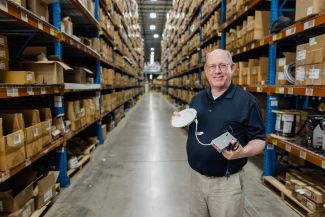How to Avoid Overspending on Lighting
- July 27, 2023
- Product Promotions
- Lighting
- Electrical
Replacing HID or fluorescent lamps with LED is easy. Just buy an LED that’s about half the watts, and you should get the right amount of light, right? Well, not exactly. That way of thinking will cause you to over-illuminate your area and overspend on lighting. To help you save money, here’s how you can upgrade your thinking and not your budget.

BUY LUMENS, NOT WATTS
People have always ordered lights by watts, but HID and LED watts are not created equal. Trying to convert HID watts to LED watts is a surefire way to overspend and over-light your area. Conventional thinking has been that an LED light should be roughly half the watts of the light it replaces, but as LED chips become more efficient, light fixtures don’t need as much power to produce the same amount of light.
Instead of buying a certain number of watts, buy the number of lumens you need to appropriately light your area. You no longer need a 125W LED wallpack to replace your 250W HID wallpack. Why is that? Optical control of LED lighting fixtures is 95% or higher for efficiency on putting lumens on the target area compared to old HID/fluorescent, which might be only 50% to 60% efficient at best. Depending on your color temperature, you might be able to get enough lumen output to light your area correctly with a 79W or even 62W LED wallpack.
The result is savings on fixture and energy costs. For example, let’s say you are replacing 10 400W metal-halide fixtures in your parking lot. In the past, you would replace them with 10 200W LEDs, but what if you could use 100W fixtures and still get sufficient light? When you take the total difference of 1,000 watts times eight cents per kilowatt hour (the average price per kilowatt in MN) multiplied over the 20-year lifespan of an LED fixture, you’ll see that you are saving over $500 per fixture in energy costs alone. That’s $5,000+ in energy savings over the life of those 10 fixtures.
FOLLOW ILLUMINATING ENGINEERING SOCIETY (IES) GUIDELINES
How do you know how much light is appropriate for a certain area? The IES has recommended practices that specify appropriate foot-candles for any kind of area you can think of from an office building to a parking lot to a bowling alley. Foot-candles are the measurement of light intensity at a given point, and sticking to the IES recommended levels can help you avoid excess cost and light pollution.
If your office is supposed to be 50 foot-candles, selecting the LED flat panel or troffer that provides enough lumen output to reach 50 foot-candles is more cost-effective than trying to guess based on the number of watts and can even save you 40-50% of the total cost.
One lumen per square foot equals one foot-candle, but it is easier to do it in reverse. One foot-candle is equal to 10.7 lumens. In this case, if you need 50 foot-candles, you can multiply 50 by 10.7 to determine how to illuminate one square foot of space correctly.
USE YOUR LIGHTING RESOURCES
What’s the quickest way to determine which lights will get the most bang for your buck? Reach out to Van Meter’s lighting experts to discuss your application. Our lighting specialists can perform photometrics to determine how much light you need, and they know which fixtures will work best. Call 1-800-247-1410 to save money on your next project.

ARTICLE BY:
CHARLES DIX
EMPLOYEE-OWNER, LIGHTNING SUPERVISOR